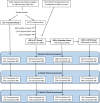Evaluating the Effectiveness of Diabetes Shared Medical Appointments (SMAs) as Implemented in Five Veterans Affairs Health Systems: a Multi-site Cluster Randomized Pragmatic Trial
- PMID: 33532956
- PMCID: PMC8175536
- DOI: 10.1007/s11606-020-06570-y
Evaluating the Effectiveness of Diabetes Shared Medical Appointments (SMAs) as Implemented in Five Veterans Affairs Health Systems: a Multi-site Cluster Randomized Pragmatic Trial
Abstract
Objective: To examine whether diabetes shared medical appointments (SMAs) implemented as part of usual clinical practice in diverse health systems are more effective than usual care in improving and sustaining A1c improvements.
Research design and methods: A multi-site cluster randomized pragmatic trial examining implementation in clinical practice of diabetes SMAs in five Veterans Affairs (VA) health systems was conducted from 2016 to 2020 among 1537 adults with type 2 diabetes and elevated A1cs. Eligible patients were randomly assigned to either: (1) invitation to participate in a series of SMAs totaling 8-9 h; or (2) continuation of usual care. Relative change in A1c (primary outcome) and in systolic blood pressure, insulin starts, statin starts, and anti-hypertensive medication classes (secondary outcomes) were measured as part of usual clinical care at baseline, at 6 months and at 12 months (~7 months after conclusion of the final SMA in four of five sites). We examined outcomes in three samples of SMA participants: all those scheduled for a SMA, those attending at least one SMA, and those attending at least half of SMAs.
Results: Baseline mean A1c was 9.0%. Participants scheduled for an SMA achieved A1c reductions 0.35% points greater than the control group between baseline and 6-months follow up (p = .001). Those who attended at least one SMA achieved reductions 0.42 % points greater (p < .001), and those who attended at least half of scheduled SMAs achieved reductions 0.53 % points greater (p < .001) than the control group. At 12-month follow-up, the three SMA analysis samples achieved reductions from baseline ranging from 0.16 % points (p = 0.12) to 0.29 % points (p = .06) greater than the control group.
Conclusions: Diabetes SMAs as implemented in real-life diverse clinical practices improve glycemic control more than usual care immediately after the SMAs, but relative gains are not maintained. Our findings suggest the need for further study of whether a longer term SMA model or other follow-up strategies would sustain relative clinical improvements associated with this intervention.
Trial registration: ClinicalTrials.gov ID NCT02132676.
Keywords: shared medical appointment, peer support, disease management, implementation, diabetes mellitus, pragmatic clinical trial.
Conflict of interest statement
The authors declare that they do not have a conflict of interest.
Figures

Similar articles
-
Effectiveness of shared medical appointments delivered in primary care for improving health outcomes in patients with long-term conditions: a systematic review of randomised controlled trials.BMJ Open. 2024 Mar 7;14(3):e067252. doi: 10.1136/bmjopen-2022-067252. BMJ Open. 2024. PMID: 38453205 Free PMC article.
-
The Shared Health Appointments and Reciprocal Enhanced Support (SHARES) study: study protocol for a randomized trial.Trials. 2017 May 26;18(1):239. doi: 10.1186/s13063-017-1959-7. Trials. 2017. PMID: 28549471 Free PMC article. Clinical Trial.
-
The Invested in Diabetes Study Protocol: a cluster randomized pragmatic trial comparing standardized and patient-driven diabetes shared medical appointments.Trials. 2020 Jan 10;21(1):65. doi: 10.1186/s13063-019-3938-7. Trials. 2020. PMID: 31924249 Free PMC article.
-
Shared Medical Appointments: Impact on Clinical and Quality Outcomes in Veterans With Diabetes.Qual Manag Health Care. 2016 Jul-Sep;25(3):176-80. doi: 10.1097/QMH.0000000000000098. Qual Manag Health Care. 2016. PMID: 27367218
-
Shared Medical Appointments May Be Effective for Improving Clinical and Behavioral Outcomes in Type 2 Diabetes: A Narrative Review.Front Endocrinol (Lausanne). 2017 Oct 4;8:263. doi: 10.3389/fendo.2017.00263. eCollection 2017. Front Endocrinol (Lausanne). 2017. PMID: 29046662 Free PMC article. Review.
Cited by
-
Using the RE-AIM framework to evaluate the impact of shared medical appointments for diabetes mellitus: a systematic review and meta-analysis.BMC Prim Care. 2025 Jun 5;26(1):192. doi: 10.1186/s12875-025-02875-1. BMC Prim Care. 2025. PMID: 40474092 Free PMC article.
-
Understanding Gaps in the Hypertension and Diabetes Care Cascade: Systematic Scoping Review.JMIR Public Health Surveill. 2024 Feb 16;10:e51802. doi: 10.2196/51802. JMIR Public Health Surveill. 2024. PMID: 38149840 Free PMC article.
-
Effectiveness of shared medical appointments delivered in primary care for improving health outcomes in patients with long-term conditions: a systematic review of randomised controlled trials.BMJ Open. 2024 Mar 7;14(3):e067252. doi: 10.1136/bmjopen-2022-067252. BMJ Open. 2024. PMID: 38453205 Free PMC article.
-
Twenty-first century management of diabetes with shared telemedicine appointments.J Telemed Telecare. 2025 Apr;31(3):446-453. doi: 10.1177/1357633X231184503. Epub 2023 Jul 20. J Telemed Telecare. 2025. PMID: 37475531 Free PMC article. Review.
-
A Multi-Method Study of Patient Reach and Attendance in a Pragmatic Trial of Diabetes Shared Medical Appointments.Clin Diabetes. 2023 Fall;41(4):526-538. doi: 10.2337/cd23-0015. Epub 2023 Sep 8. Clin Diabetes. 2023. PMID: 37849523 Free PMC article.
References
-
- Ligthart S, wan Herpt TTW, Leening MJG, et al. Lifetime risk of developing impaired glucose metabolism and eventual progression from prediabetes to type 2 diabetes: a prospective cohort study. Lancet Diabetes Endocrinol. 2016;4(1):44-51. - PubMed
-
- Davies MJ, D’Alessio DA, Fradkin J, et al. Management of Hyperglycemia in Type 2 Diabetes, 2018. A Consensus Report by the American Diabetes Association (ADA) and the European Association for the Study of Diabetes (EASD) Diabetes Care. 2018;41(12):2669–2701. doi: 10.2337/dci18-0033. - DOI - PMC - PubMed
-
- Kirsh S, Watts S, Schaub K, et al. Training Manual, VA Shared Medical Appointments for Patients with Diabetes: Maximizing Patient & Provider Expertise to Strengthen Care Management. 2008. http://www.queri.research.va.gov/tools/diabetes/shared-med-appt.pdf. Accessed 1 August 2016.
Publication types
MeSH terms
Associated data
Grants and funding
LinkOut - more resources
Full Text Sources
Other Literature Sources
Medical

